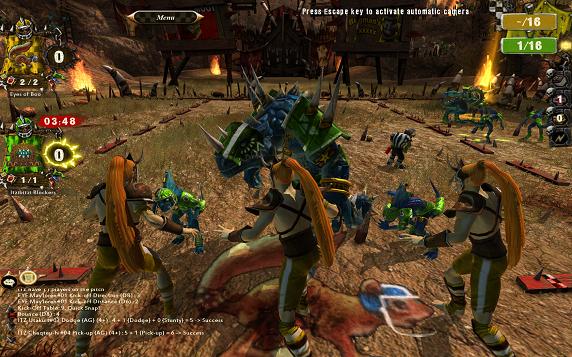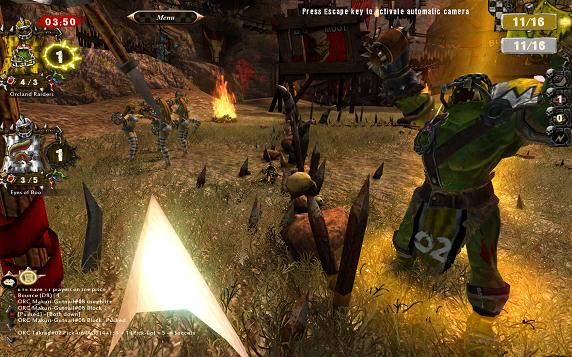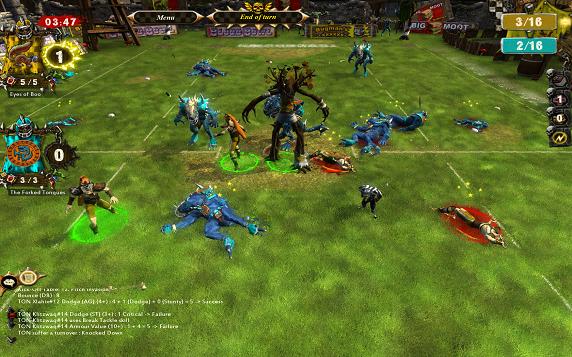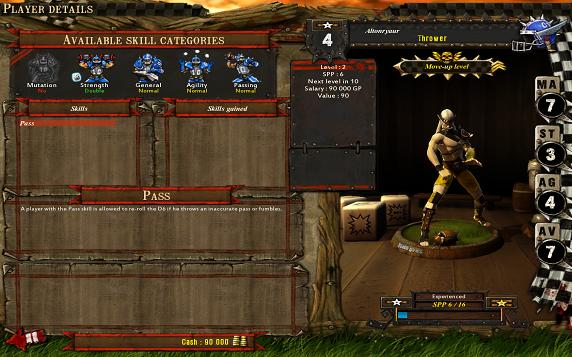
A. Asohan’s Games column in The Star which ran in the 1990s talked mostly about role-playing games. But he devoted column inches to boardgames on at least three occasions that I can recall. They were Space Hulk, which I’ve since played, Dune, which I know is now impossible to find but I have a vague hope of finding the time someday to craft my own copy of it, and Blood Bowl. This last one is one boardgame I know I’ll probably never get to play as like many of Games Workshop’s products, the basic set for the game includes only the barest minimum and you need to buy and customize a full team of miniatures to get the full experience. So the videogame version produced by Cyanide is the next best thing.
The version I have is the Dark Elves Edition which was released late last year.Cyanide has since released a newer Legendary Edition. However, the main difference is that the new version implements 11 more races. Since I wasn’t sure that I’d be interested long enough to try out that many teams, I opted not to go for the upgrade and try the older version first. Customers who own the previous versions get a discount when upgrading, so I figured I can always do it later.
Blood Bowl is basically a parody of American football. Each team fields up to 11 players at a time and the objective is to have one of your players carry the ball into the opponent’s endzone. Both teams are allowed to pre-position their players on their half of the field however they please prior to kick-off subject to certain rules. For example, each team must field at least three players at the line of scrimmage which divides the field into two halves. At the beginning of every drive, one team is designated the kicker and the other team the receiver. The kicker plays defense as one of their players must kick the ball somewhere into the opponent’s half of the field. The receiver plays offense and upon receiving the ball must recover it and find some way to score.

Players are allowed to pass the ball and to smash into opposing players (this is called blocking). Passing the ball between adjacent is called handing off and you’re allowed to do this as many times as you want in a turn. However, throwing a ball between two distant players is called passing and you’re only allowed to do one pass per turn. Your players who start the turn adjacent to an opponent player are allowed to block him, and you can do this as many times as you want, but combining a move action and a block is called a blitz and you’re only allowed one blitz per turn. The game also allows players to attack opposing players who have fallen down, but this is a foul and if noticed by the referee, the offending player will be ordered off the field.
A Blood Bowl match consists of a total of sixteen turns for each team, divided into two halves of eight turns each. The half-time is important as it gives players who have been knocked out a chance to recover. You can activate and move any and all of your players during your turn, but you must complete all actions with one player before activating the next. But here comes the twist. Your turn ends normally when you finish activating all of your players but it can also end prematurely if one of your players attempt to do an action that requires a die roll and fails at it. This causes your turn to end immediately and play switches to your opponent, even if you have players that haven’t been activated yet. This is a fantastic rule that makes Blood Bowl feel very different from other turn-based games.
The game uses two different sets of dice, all of which are six-sided. One set has special symbols on all faces and is used only for blocking. These symbols determine whether the attacking or defending player is knocked down or whether the defender is just pushed away. Blocking uses the Strength statistic of the players involved. If one player has more Strength than another, then his coach rolls two dice and chooses which result to use. If a player has twice as much Strength, his advantage increases to rolling three dice and choosing a result. If both players have the same Strength, only one die is rolled.

The other set has normal numbers from 1 to 6 and is used for all other skill checks. For Agility-based checks, the number you need to roll is essentially the inverse of the relevant statistic value. So if your Agility is 4 for example, you fail only on a 1 or a 2. Different tasks have different modifiers to increase or lower the difficulty but a 1 is always a failure and a six is always a success. Tasks requiring a die roll includes trying to move out of an opposing player’s tackle zone, attempting a pass or receiving one and even picking up the ball when it is on the ground. The other type of check is for injuries. In this case, the opponent rolls two dice and tries to score higher than your player’s Armor Value. Success means that your player has been injured and needs to roll on a chart to determine what the exact injury is, which includes immediate death.
Players may have skills that help with different tasks. One of the hardest thing to learn in Blood Bowl is the wide variety of skills and how they work. Many skills work by giving the player a free reroll when he fails at doing the relevant task. For example, a player with the Catch skill may reroll the die when he fails at catching the ball during a pass attempt. Some other skills work different however, so you need to learn them on a case-by-case basis. The Block skill for example, changes the results of the block dice results in a very specific way.
The beauty of this system is that a small difference in statistics results in a tremendous change in gameplay. The Wood Elf team I mostly played for example, have Agility of 4 across the board, which is only 1 point higher than the average of 3, but this is enough to allow them to duck and weave through the pitch. Add in the Dodge skill which allows them to reroll failed rolls, and it becomes really difficult for opponents to stop them from getting where they want to be. Similarly, Black Orcs have a Strength of 4, which is enough to ensure that they almost always get to roll two dice and pick the result, a huge advantage when blocking.

These differences in ability translate to different team tactics on the pitch. Elves are fast, can dodge past opponents’ tackle zones and their elite Wardancers can even leap over the heads of defenders. This means that once they manage to get hold of the ball, it’s almost impossible for the opposing team to stop them from scoring. On the other hand, they have poor armor and only average strength, plus their players are expensive, so they must keep their distance from opponents. This means that when the other team grabs the ball, it’s almost impossible for the elves to get it back too. The best they can hope for is to slow down the ball carrier and his cage of protectors as much as possible as it moves down the pitch and wait for them to make a mistake or perhaps intercept a pass.
At the other end of spectrum, the Chaos team are tough and strong but so clumsy that they have trouble even picking up the ball. So their best strategy is to ignore the ball and do their best to hurt as many of the opposing players as possible. Once most of the players on the other team are dead or knocked out, its easy enough for them to take their time with the ball and stroll leisurely to the endzone. With just the nine teams in this edition, there’s already plenty of variety. The humans for example, are average joes who can do a little bit of everything but excel at none of them. The Skaven are the fastest team but are more fragile than the elves. However, they’re cheap, so you throw lots of rats at the ball and hope one of them makes it through the defense.
Blood Bowl also includes rules for league play and this is where the fun really is. You earn money after every match which you can spend on improving your team. You can buy additional players, invest in an apothecary which can help prevent death or injury, buy cheerleaders which makes some kick-off random events go in your favor, or buy team rerolls which can be used to reroll die results that you don’t like in matches. Your players can also gain experience but this involves rolling dice to see what you get. Being able to pick a new skill is the most common result but getting a statistic increase in Strength or Agility can easily result in a very powerful player.

Now all that is about Blood Bowl the boardgame, which I’m happy to report really is all it’s cracked up to be, how about this videogame version? First, it’s a completely faithful adaptation, implementing every aspect of the rules exactly as written, so it has that going for it. It also has decent art and passable animations. It also tries to go for a sense of humor that matches pretty nicely with the world the game is set in. It’s not great though and it’s certainly clear that Cyanide isn’t one of top notch development houses with AAA-quality production values. Unfortunately, everything else is pretty bad.
First, there’s the user interface which is atrocious and makes it hard to find even basic information. It would have been trivial to let the player mouse over different options and show what the odds of successfully doing something is, but this game lets the opportunity pass. So when you order a player to move out of an opponent’s tackle zone, it shows you that you need a die roll, but doesn’t tell you what results you need to succeed. Next, the tutorials included in the game are laughable. Ok, the game comes with PDFs of the full rules as well as a very pretty strategy guide, but that doesn’t excuse the pathetic in-game tutorial.
But most damning of all is that the game’s AI is completely useless. It takes stupid risks when they are completely unnecessary, such as almost always having its players roll a die to move farther, but is far too conservative when it comes to trying to score when it has the ball. It makes obvious mistakes about who to blitz as well, frequently choosing to blitz one of my players who is weaker than going for the one who is actually carrying the ball. And it has no concept of how many turns left in the game there are, so it will maneuver its players to keep a ball in its possession safe even though it is the last turn and it is going to lose. Once I understood how the rules work, I’ve never lost a game to the AI, even though it blatantly cheats by having lots of high level players with tons of skills and a ridiculously low team value. It makes the team development aspect completely pointless as no matter how many games I win, the AI’s teams will always have better players.
Due to this, I’m already bored of the single-player game. I guess the right thing to do would be to move online and try to find some multi-player matches and I understand this is how the majority of players play this game. But that takes some organizing and time, and from what I hear, you need to choose the leagues you join carefully as well as the public servers are full of hackers and cheaters. I’ll probably try to join one of the QT3 league after the holiday season. So my verdict is that Blood Bowl the boardgame is excellent but this videogame adaptation is good only if you want to learn the rules or if you’re going to play online multi-player.
Leave a Reply